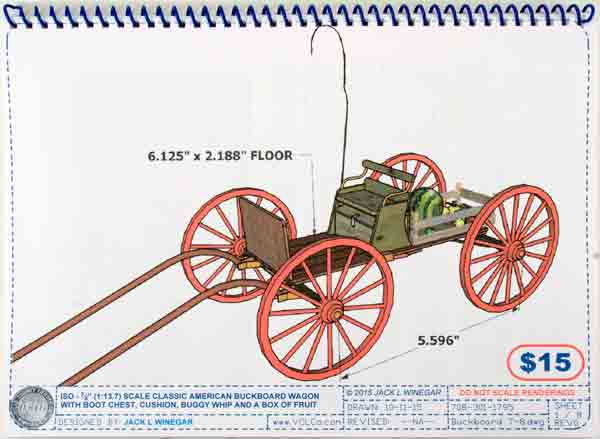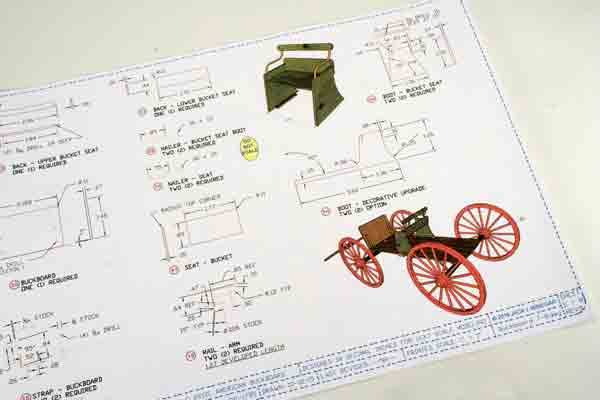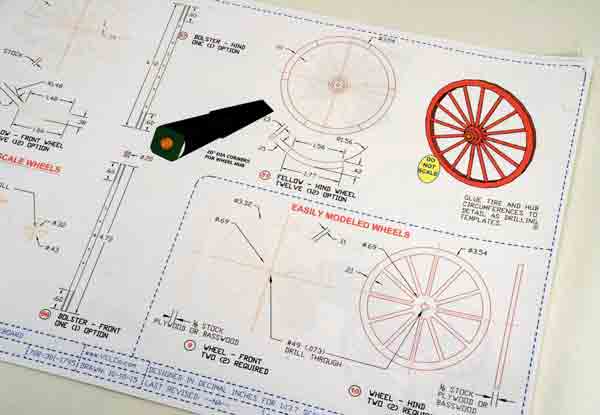Vilas County Lumber Company
12306 Lakeview Trail
Homer Glen IL 60491
Prices: 1:24 scale, $14; 1:13.7 scale, $15
Website: www.VCLCo.com
Comprehensive plan set for the construction of a buckboard wagon; four 91/2″ x 13″ pages and six (1:24) or eight (1:13.7) 13″ x 19″ pages; spiral bound; printed in color; computer-generated drawings; fraction/decimal/millimeter chart included; decimal/inch conversion chart for four model scales included; conversion-to-other-scales chart included
Pros: History, description, and prototype photo included; all parts numbered and cross referenced; easy-to-understand drawings; dimensions are actual for
the scale of the plans
Cons: Part’s materials not always clear; if you want to lay the sheets side by side, you’ll have to remove them from the spiral binding
Sent for review were two identical (except for scale) plan sets for a buckboard-style wagon, used for a variety of different jobs virtually everywhere in this country during the 19th and into the early 20th century. The plan set includes a brief history of this type of wagon (the actual “buckboard” was the frontmost board of the wagon, which provided the driver some protection as well as a footrest) as well as a photo of a typical prototype, although there were hundreds of variations and modifications to the original design.
Modeling considerations and suggestions follow, along with a fraction/decimal/millimeter conversion chart and a scale-dimension conversion chart (in decimals) for four different large scales.
Then come the actual drawings, in either half inch (1:24) or seven-eighths inch (1:13.7) scale. These are computer-generated drawings and are printed in color for clarity (although the yellow ink is a little difficult to make out at times). Each part of the model is given a number. I might mention, at this point, that the model is constructed in much the same way as the prototype. And, like the prototype, the model can be modified or changed in a wide variety of different ways to suit specific needs.
Every part is drawn in engineering style, with dimensions in decimals. There are also perspective drawings that explain how certain assemblies go together. These are quite good and go a long way in clarifying things. For instance, wheels can be built prototypically, with segmented hubs and individual spokes, or they can be cut from the solid as a single piece. Plans for a special, clever wheel-building jig are included. Associated hardware is also well covered—brakes, lamps, side stakes, brackets, etc.
A materials list is supplied. The plans producer assumes that the builder will be using as many commercial parts as possible. Hence, the materials list mentions the manufacturer’s name (under “Manufacturer”) and the part number (under “Material”). This is not helpful for those who wish to scratchbuild everything. I would like to know the actual material—wood, brass, steel, etc. However, much of this information can be gleaned from the drawings themselves.
As vehicles go, this one is about as simple as they come. While certain things about the model might make for a little head scratching for the novice, an experienced modeler using these excellent plans should have no trouble building an authentic, realistic model of a classic American wagon.
















